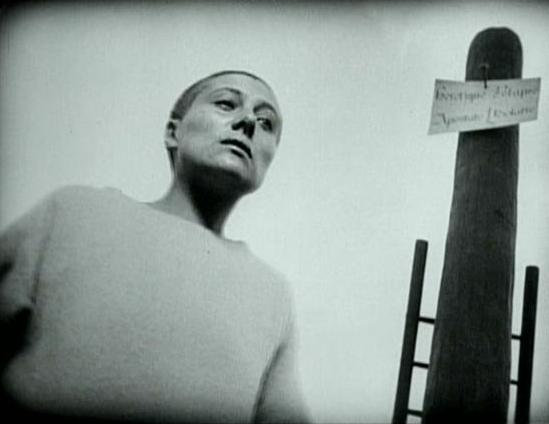
What follows is an excerpt from Hans Urs von Balthasar’s Bernanos: An Ecclesial Existence.
—
But what if sin lives in the Church herself, if sin anchors itself most securely precisely where the Church is most vulnerable–in her hierarchical structure? What if the horror occurs that the face of Satan should begin to glimmer in the very heart of that trinitarian image, which is the relationship of ecclesial obedience? An since holiness cannot cease being holy, in this case the man holding the office would become an inverted principle: he would become an offerer of sacrifice, not in his capacity as one who loves, but as sinner.
All of Bernanos’ efforts in his Joan, Heretic and Saint go to showing that the tribunal that condemned Joan of Arc was “regular”, and that, “wonder of wonders”, it was “a tribunal made up of churchmen”. Péguy makes Joan’s judges to be a choir of the damned. Claudel, for his part, degrades them into representatives of all bestial vices: they are nothing but a subspecies of man and empty masks. In Bernanos, however, they are indeed scoundrels, but they possess demonic greatness and are exercising their offices with legitimacy: “It would be useless, by means of overly subtle distinctions, to try to turn this regular and regularly constituted tribunal into an exceptional case, a kind of tragic Punch-and-Judy show. To reduce such shabby ruses to nothing, only one fact suffices: the holy Inquisition itself intervened in the trial. The seal of the apostolic delegate is to be seen alongside that of the bishop of Beauvais, at the bottom of the iniquitous sentence.” The sentence remains uncontested until the opening of the trial of rehabilitation. All the original judges end their lives in very high offices and positions of honor.
This is the Church, even if represented by the most unworthy of men, and still the Church even if violated in her holiest sphere: the hierarchical Church, doing sinfully what she should have done out of love–namely, offering up what is holy to God. In the midst of the official Church, sanctity agonizes. Bernanos apostrophizes Joan as follows: “They saw your pale cheeks ravaged by fever. They saw the beads of sweat on your small stubborn forehead, and the quivering of your mouth, when, in the stuffy courtroom, you suddenly refused to resist them any longer after so many days of harassment, and you surrendered your word and your oath, you, the finest flower of chivalry!” Behind this picture of a prey that is being hunted down and driven in circles into an ever narrower impasse, of an animal that begins to tremble as it approaches the horror, do we not sense the presence of the “Second Mouchette” almost palpably? This Mouchette is a darker sister of Joan of Arc, but her destiny can be best understood when we consider her alongside Joan’s experience. And, just as Mouchette is a work of compassion for the inescapable suffering of creatures, so too Joan: “As we approach the finale and we see the harassed saint begin to totter as she is forced from hour to hour to engage in her own naive and fragile defense, an unexpected pity for her judges suddenly takes hold of you.” For the moment, however, it is the judges themselves who are absorbed in self-pity as they strain themselves through a show of compassion to preserve their victim from the fires of hell. Should she not recant, then she is excluded from the communion of saints and forever abandoned to her damnation: “They open out their arms to her, entreating her and calling out to her soul with tender words.” There then succeeds in happening what no human power could have brought about: the holy equilibrium of a soul belonging to God is disturbed in its very center, wounded and broken. The knife has bored its way into the person’s deepest mystery and has imposed there a lethal opening:
The words she has just heard in silence, with her precious little head bent humbly toward the ground, have cut her off from everything that lives, from the Holy Universal Church, from a forgiven universe. They have wounded her to the quick in her soul’s very heart, at the source itself of her being, which was her tender, her pure hope. Or, rather, it’s love, her innocent love, the sweet name of Jesus itself, which has just burst in her heart. You, the bishops of Thérouanne and Noyon, masters Beaupère, Midi, Erart, and Maruice, Licentiate Venderès and licentiate Marguerie: she is yours, take away her prostrate body… . Whoever possessed the secret of this strange moment would have the key to all the rest; but the secret is well kept. … Like those insects that insert a worm in the heart of their living prey, they have made doubt enter her child’s soul. And, once its sordid fruit has come full term, they no longer recognize their victim. They search for her and beg her to give them what, through their fault, she is no longer capable of giving: a pure, untouched word that would bring them certitude or forgiveness. They have literally stolen her soul. Still for two days, and with growing impatience, they will vainly shake this corpse. And finally, weary of the ridiculous struggle, they will cast their broken toy into the fire.
Indeed, in the midst of the Church sanctity does agonize. The human sacrifices of Vizlipuzli are repeated here at a much more subtle and cruel depth, a level Claudel never reaches: this agony is a spiritual, more, an ecclesial agony. As Péguy had intuited, it is when they rob Joan of her Christian hope that her torturers have perfected her sacrifice in the image of the sacrifice of the cross. But Bernanos is here the first to show that this is a sacrifice effected by the Church. Time and again he evokes the distinction that Père Clérissac, O.P., makes between suffering for the Church and suffering through the Church, that is, at the hands of the Church. The “mystical blood“, which overflows from the heart of the Church runs down in atonement over those armed with daggers, is a blood that flows in communion with him who, on the Cross, was the most solitary of all. It is the blood that pours into the chalice of the Church’s Holy Sacrifice. The Chantal of Joy is, pure and simple, but the transposition of this drama into our own time. Bernanos remained fixated on this mystery: “Whoever possessed the secret of this strange moment would have the key to all the rest.” Just as many mystics remain fixated before the Cross as they see the Redeemer’s physical body being drained of blood in its forsakenness, so too Bernanos would not be made to budge from the contemplation of this same suffering in the Lord’s Mystical Body: “We must look at this agony face to face. Or, better, we must enter into it. How deep it is, and how cold! All the fire of the executioner’s stake cannot succeed in warming it.”
—
Pages 279-281.
Translated by Erasmo Leivas-Merikakis. Ignatius Press. (c) 1996












